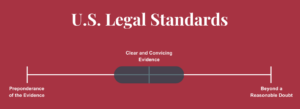If you have been injured in an accident, you might wonder whether you’re entitled to compensation and considering filing a personal injury claim.
A personal injury claim can result in a massive settlement — depending on how severe your injuries are and how they’ve impacted you — but it’s not a simple case of reporting the accident and waiting for cash to land in your bank account.
To claim compensation, you must prove that someone else acted recklessly or negligently and that their action (or inaction) caused your injuries, resulting in losses. These losses can be financial (such as losing wages because you can’t work), physical (such as losing mobility or strength after breaking your leg), or emotional (like suffering from depression after your accident, which affects your relationships).
To ensure justice and fairness, our legal system upholds specific standards that anyone seeking to bring legal action must meet. These standards relate to a concept called the burden of proof.
In this blog post, we explain the burden of proof and how to prove negligence in a personal injury claim.
Areas in Greater San Antonio We Serve
What Is the Burden of Proof?
In simple terms, the burden of proof is an obligation for a person to prove a case. The onus is on the person or party with the burden of introducing evidence supporting their argument.
For example, in a criminal case, the prosecution has the burden to prove the defendant is guilty. Until the jury (or the judge, in a bench trial) delivers a guilty verdict, the defendant is cloaked in the presumption of innocence, which is where the phrase “innocent until proven guilty” comes from. This also means that a defendant doesn’t need to present any evidence in their case (although many do), as they do not need to prove their innocence.
The Burden of Proof in Personal Injury Cases
In a civil case — which includes personal injury claims — the burden is on the plaintiff (or the person or party bringing the case against the party they believe is responsible). This means if you’re in a car accident and want to claim compensation, the burden of proof is on you.
It’s your responsibility to prove the defendant was negligent and that their actions resulted in your injuries.
You can do this in several ways. If we take the car accident example, you might offer evidence such as the crash report filed by police that shows the defendant was speeding before they crashed into you. You might back this up with supporting evidence, such as witness testimony that the other driver was going too fast, an accident reconstruction showing that the accident wouldn’t have happened if the driver hadn’t been speeding, and medical records that show you sustained your injuries in the accident.
But that begs the question, “how much proof is enough?”
The Standards of Proof in the U.S. Legal System
There are different standards relating to the burden of proof in our legal system:
- Beyond a reasonable doubt
- A preponderance of the evidence
- Clear and convincing.
Let’s break those down.
Beyond a Reasonable Doubt
Even if you only have a cursory knowledge of the law — or you’ve watched a few episodes of any legal drama or police procedural — you’ve probably heard the term “beyond a reasonable doubt.”
This is the prevailing legal standard in criminal cases, where, as the name suggests, the prosecution must prove the defendant’s guilt “beyond a reasonable doubt.” To give you an example of what reasonable doubt can look like, imagine you’re serving on a jury in a murder case. If you make up your mind that the defendant is not guilty because they seem like a good person who couldn’t possibly have committed the crime, that would be unreasonable. It’s your duty to be impartial and consider only the evidence introduced during the trial when making your decision — not how you personally feel.
However, if multiple witnesses testify to seeing a person at the crime scene and claim it was the defendant, but each offers a different description, that may be enough to introduce reasonable doubt because it calls into question whether the witnesses saw the defendant or if it was someone else.
Beyond a reasonable doubt is the highest standard in any court of law. It is specifically reserved for criminal cases because of the severe consequences of a potential conviction. In the words of Benjamin Franklin, “it is better a hundred guilty persons should escape than one innocent person should suffer.”
A Preponderance of the Evidence
This legal standard is a much lesser burden than beyond a reasonable doubt. It’s the most commonly held standard in civil cases, including personal injury.
Proving negligence in a personal injury claim means you must show by a preponderance of the evidence — meaning more likely than not — that the defendant’s actions caused your injuries.
A preponderance of the evidence may be a lower burden, but that doesn’t mean it’s easy. You still need strong evidence that tips the scales in your favor.
Clear and Convincing
Clear and convincing evidence is a medium-level burden and applies to certain civil cases, including loss of parental rights and probate matters.
One element required this higher burden in the highly publicized legal battle between actors Johnny Depp and Amber Heard. As a defamation case, the legal standard was by a preponderance of the evidence. However, because of the parties’ celebrity status, the jury had to determine whether the parties had proven by clear and convincing evidence that the actions taken or statements made were done with actual malice.
Depp v Heard was unique in that Heard counter-sued Depp, meaning she had her own burden to prove in addition to defending Depp’s claims.
But what does clear and convincing mean? Clear and convincing evidence must be substantially more true than not, and the finder of fact (either a judge or jury) must have a firm belief and conviction in the facts.
If you imagine a line with a preponderance of the evidence on one end and beyond a reasonable doubt on the other, clear and convincing sits along the middle.

How to Meet the Burden of Proof in Your Personal Injury Claim
Now we know that you need to prove negligence in a personal injury claim by a preponderance of the evidence, let’s look at how to do it.
To meet the personal injury burden of proof, you must gather evidence supporting your case. This can include:
- Medical records: To prove the severity of your injuries and that they occurred during the accident.
- Witness statements: To support your version of events, even if the defendant paints another picture.
- Crash reports: To document injuries sustained in an auto accident and outline any contributing factors to the crash, such as road rage, speeding, or driving under the influence.
However, to win your case, you must do more than simply present evidence. You must create a narrative that ties the evidence together and clearly shows the defendant is liable.
Our personal injury lawyers in McAllen and San Antonio can help you collect evidence, select the most relevant pieces (for example, you may have 20 photographs showing your injuries from different angles, but you don’t necessarily need to present them all), and persuasively argue your case. We can also get expert opinions to testify about your injuries’ cause and long-term prognosis.
Challenges to Proving Negligence in Your Personal Injury Claim
Proving your personal injury case can be challenging, even with the lower burden of proof.
The defendant to your claim may argue you were partially responsible for your injuries. Because Texas has modified comparative negligence laws, this can impact how much compensation you’re entitled to. If they can show you were more than 50% at fault for the accident, you won’t be able to claim at all. This is where evidence such as CCTV footage and witness statements can make a massive difference to your claim.
Another challenge you may face is the defendant arguing you didn’t sustain your injuries in the accident. This is why seeking medical attention is so vital — it provides a record.
If you’re worried about paying medical bills, speak to a personal injury lawyer. If you have a claim, we can help you arrange treatment and postpone payment until you receive compensation.
See if you’re entitled to compensation and get help meeting the burden of proof in your personal injury claim. We offer a free, no-obligation case review so you can see if we’re the right firm for you. To contact our McAllen and San Antonio personal injury lawyers, call 855-LAW-NINJA, submit a confidential message via our contact form, or pop into one of our offices.

